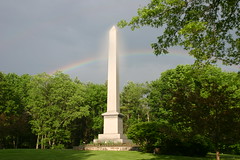Honored for his roles as pioneer, colonizer, governor, and religious leader, Brigham Young (1801–77) was best known as simply “Brother Brigham.”
A beloved leader and wise counselor, he served as President of the Church from 1847 until his death in 1877. This historic park is a representation of the lives and industry of Brigham Young and the early pioneers. Statues in the park depict pioneering efforts.
Items such as the waterwheel powered by City Creek, a portion of the old wall of Brigham Young’s farm that stands in place, and the gardens are all reminiscent of the farm once found here. The Young’s family estate, which included this site, extended north of Eagle Gate nearly three blocks. It included the eastern half of the block where the Lion and Beehive Houses are located and continued east up the hill for approximately two blocks. The property was large enough to accommodate carpenter and shoe shops, as well as a pigeon house, barns, sheds, and corrals. What they called the “upper garden” had vegetables, fruits, and an orchard of apple, peach, pear, and walnut trees, as well as beehives.
 Statues in the park depict various pioneering activities. Stonecutters are shown at work with hammer and chisel.
Statues in the park depict various pioneering activities. Stonecutters are shown at work with hammer and chisel.David M. Whitchurch
 Brigham Young’s layout of Salt Lake City began at Temple Square, and surrounding ten-acre blocks were subdivided for homes.
Brigham Young’s layout of Salt Lake City began at Temple Square, and surrounding ten-acre blocks were subdivided for homes.David M. Whitchurch
On the inside of the west wall of the Brigham Young Historic Park are two plaques honoring the Prophet Joseph Smith for his ingenious design in laying out a city. Following the pattern established by Moses in the Old Testament, Joseph proposed a city with a temple in the center and streets running north-south and east-west from there. Farming areas were located on the outskirts of town, allowing the farmer and his family to enjoy all the urban advantages of schools, public lectures, and social gatherings.
 This plaque notes an award for city design. Salt Lake City was laid out according to the pattern revealed to the Prophet Joseph Smith for the city of Zion.
This plaque notes an award for city design. Salt Lake City was laid out according to the pattern revealed to the Prophet Joseph Smith for the city of Zion.David M. Whitchurch
 Brigham Young Historic Park contains several statues of individuals engaged in activities typical of the era.
Brigham Young Historic Park contains several statues of individuals engaged in activities typical of the era.David M. Whitchurch
___________________________________________________________________
___________________________________________________________________
Brigham Young University Religious Education presents
Hallowed Ground Sacred Journeys
Featuring BYU Religious Educators teaching about sites significant in
The Church of Jesus Christ of Latter-day Saints
For more information, or to visit our interactive web site with dozens of additional sites to explore,
please visit VirtualTours.BYU.edu
Hallowed Ground Sacred Journeys
is a co-production of
This blog is a public service of The Watchmen Institute
and is distributed by B.U.M.P. LTD.
All Rights Reserved





0 comments:
Post a Comment